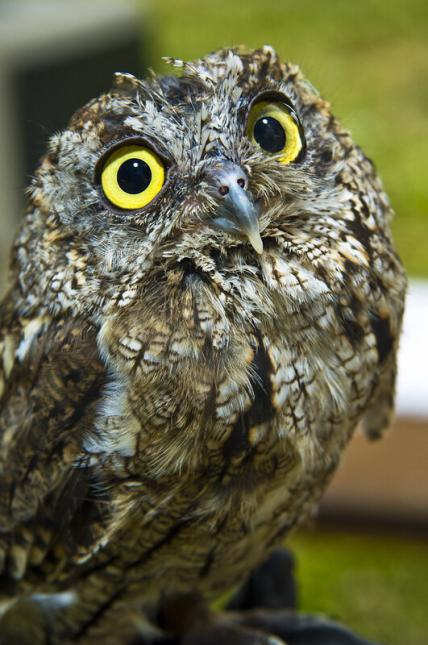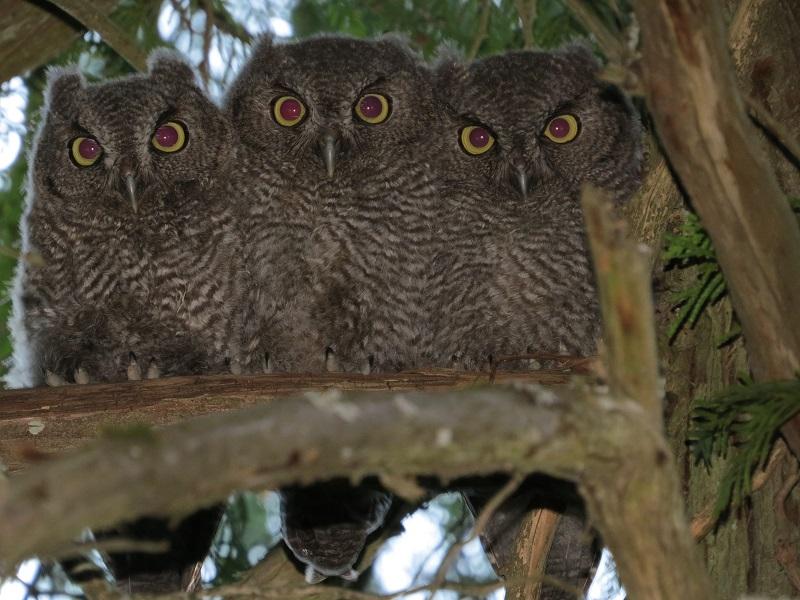This species appears to have been impacted by the presence of barred owls in western Washington. More information is needed to assess whether its population has declined or if suspected changes reflect only a behavioral response to barred owls.
Description and Range
Physical description
The western screech owl is a small owl, about 7 1/2 inches long. It has yellow eyes and a round head. It has ear tufts that it can flatten. In Washington, species can be brownish overall versus gray.
Ecology and life history
This species is found in many forest types, from urban to rural and including riparian zones and forests dominated by Douglas-fir, western hemlock, Sitka spruce and grand fir. They are virtually absent from the Columbia Basin but should be expected to occur there if suitable conditions develop along riparian zones or in small woodlots near human dwellings.
This small resident owl is strongly associated with coniferous forests although other forest types are also used.
It preys mainly on small mammals (mice and shrews), birds and insects.
Western screech owls nest in tree cavities. Clutch size averages three to four eggs. Incubation is about 26 days.
Geographic range
This owl was formerly a fairly common resident statewide except in the Columbia Basin. There are no population estimates, but this species’ population likely ranged in the tens of thousands as recently as the 1980s.
Surveys in southwestern Washington and published information from Bainbridge Island and British Columbia indicate it has either experienced a substantial population decline or has changed its vocalization behavior thereby, reducing its detectability, likely due to increased predation risk by barred owls. Other information regarding the abundance or distribution of this species is lacking and population status is unknown.
Climate vulnerability
Sensitivity to climate change
Moderate
Western screech owls may exhibit some physiological sensitivity to increased drought, as screech owl populations in southwestern Arizona declined 70% in 3 years during a drought. . Changes in the timing of precipitation and warmer temperatures may alter timing of prey availability and abundance, with potential impacts on screech owl fecundity. Similar to the northern spotted owl, this species may be sensitive to altered disturbance regimes (i.e., fire and insect outbreaks) that lead to habitat changes.
Exposure to climate change
Moderate
- Increased temperatures
- Changes in precipitation timing
- Drought
- Altered fire regimes
- Increased insect outbreaks
Conservation
Conservation Threats and Actions Needed
- Invasive species and other problematic species and genes
- Threat: Potential impacts from barred owls
- Actions Needed: Management of barred owl populations to reduce predation risk. Conduct surveys to evaluate screech owl response to barred owl presence or removal.
See the Climate vulnerability section for information about the threats posed by climate change to this species.
Resources
References
Buchanan, J. B. 2005. Western Screech Owl (Otus kennicottii). Pp 212-213 in T. R. Wahl, B. Tweit, and S. G. Mlodinow (eds.) Birds of Washington: Status and Distribution. Oregon State University Press, Corvallis, OR, USA. 436 pp.
Cannings, R. J. and T. Angell. 2001. Western Screech Owl (Otus kennicottii). The Birds of North America 597:1-20.
Elliott, K. 2006. Declining numbers of Western Screech-owl in the lower mainland of British Columbia. British Columbia Birds 14: 2-11.

